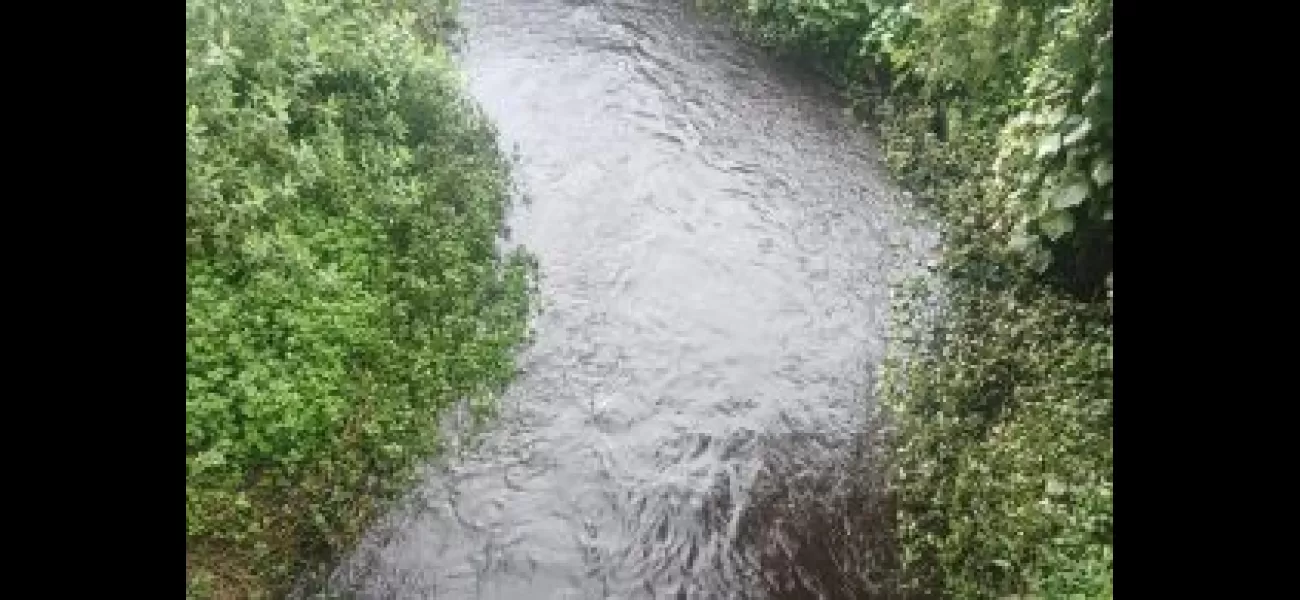Mine pollution endangers agriculture and human health.
Chemical-laced wastewater from plants and mines is posing a threat to farmlands and residents in Sukinda and Kalinganagar areas of Jajpur district during monsoon season.
July 1st 2024.

In the district of Jajpur, there is growing concern over the potential hazards that are facing farmlands in the Sukinda and Kalinganagar areas. With the arrival of the monsoon season, there is a high risk of chemical-laced wastewater from nearby plants and mines flowing into these farmlands. This development has not only put the fertility of the land at risk, but it has also posed a danger to the health of the people living in these areas and their livestock.
It has been reported that the Sukinda block has numerous chromite mines, while Kalinganagar is home to various steel and other plants. With the onset of monsoon, the chemical-laced water has mixed with rainwater and made its way into the farmlands. This has raised concerns about the impact it may have on the fertility of the land, making it unsuitable for cultivation.
Sources have revealed that the wastewater released from the Sukinda mines contains high levels of chromium and nickel. This toxic water is also seeping into the groundwater, affecting the lives and livelihoods of over 10,000 residents in villages located in the mining zone. These include Kamarda, Mashasahi, Hatisahi, Saruabila, Gurujanga, Ostapal, Kuchidabanka, Kusumghuta, Kalrangi, and Ramshola in Jajpur district, as well as Krushnapur, Odisa, Barua, Mathakhoksha, and Balijhati villages in the neighboring Dhenkanal district.
According to the directives of the Central and state governments, it is mandatory for plants and mining authorities to install machines that can filter the toxic wastewater before discharging it outside. However, due to the lack of compliance, the wastewater is flowing into Damshala and Gonda nullahs, and eventually into the Brahmani River. This has rendered the river water toxic and unsuitable for consumption. Despite repeated warnings from the State Pollution Control Board (SPCB), industries continue to discharge wastewater outside, putting the health of the local residents at risk. This is particularly concerning as the river and nullah water is regularly used by the people for their daily chores and for rearing their livestock.
It has been reported that the wastewater released from the Sukinda mines contains high levels of chromium and nickel. What is even more alarming is that this water is flowing directly into the Damshla nulla, which is the main source of water for those living in the mining areas. Many of the mines have not yet installed effluent treatment plants, while the rest have not upgraded their existing ones. Furthermore, these mines have not implemented a real-time monitoring system and have failed to comply with the directives on ensuring data connectivity with the SPCB server, as stated in the reports. It is worth mentioning that back in April 2014, the Orissa High Court had ordered a stop to the discharge of wastewater from mines into human habitats and agricultural lands. A joint investigation was conducted by the Indian Bureau of Mines, SPCB, and the deputy director of mines in Jajpur Road from December 17 to December 19, 2014, based on this order.
During the investigation, it was discovered that the rainwater flowing from the mines was not being properly treated. The toxic wastewater was mixing with rainwater and flowing into human habitats and farmlands, posing significant risks to the health of the residents and their livestock. In response, the SPCB directed the management of these mines to install effluent treatment plants and treat the wastewater emanating from their mines. However, despite some mines complying with this directive and installing ETPs, many others have refused to do so, resulting in the continued discharge of wastewater outside. As a result, the toxic wastewater is still making its way into human habitats and farmlands, causing harm to the environment and the health of the locals. Similarly, the toxic wastewater from several industrial plants in Kalinganagar is also flowing into farmlands every year. This wastewater then goes into Gonda nullah and eventually into the Brahmani and Khrasrota rivers, making their water toxic. The residents have been raising concerns to the district administration and SPCB, but their pleas have yet to be addressed. In fact, just last Friday, a plant was found to be discharging wastewater in the open on Biju Patnaik Marg near Jakhpura in Kalinganagar. The residents immediately reported this to the SPCB, stating that the wastewater flowed through Jakhpura, Aanlapal, Balungabandhi, Rungurung, Mangalpur, Kharadi villages, before finally reaching Gonda nullah in Nuagaon. When contacted, Pramod Kumar Behera, the regional officer of SPCB in Kalinganagar, stated that water samples will be collected and sent for examination. Appropriate measures will be taken based on the results of the examination.
It has been reported that the Sukinda block has numerous chromite mines, while Kalinganagar is home to various steel and other plants. With the onset of monsoon, the chemical-laced water has mixed with rainwater and made its way into the farmlands. This has raised concerns about the impact it may have on the fertility of the land, making it unsuitable for cultivation.
Sources have revealed that the wastewater released from the Sukinda mines contains high levels of chromium and nickel. This toxic water is also seeping into the groundwater, affecting the lives and livelihoods of over 10,000 residents in villages located in the mining zone. These include Kamarda, Mashasahi, Hatisahi, Saruabila, Gurujanga, Ostapal, Kuchidabanka, Kusumghuta, Kalrangi, and Ramshola in Jajpur district, as well as Krushnapur, Odisa, Barua, Mathakhoksha, and Balijhati villages in the neighboring Dhenkanal district.
According to the directives of the Central and state governments, it is mandatory for plants and mining authorities to install machines that can filter the toxic wastewater before discharging it outside. However, due to the lack of compliance, the wastewater is flowing into Damshala and Gonda nullahs, and eventually into the Brahmani River. This has rendered the river water toxic and unsuitable for consumption. Despite repeated warnings from the State Pollution Control Board (SPCB), industries continue to discharge wastewater outside, putting the health of the local residents at risk. This is particularly concerning as the river and nullah water is regularly used by the people for their daily chores and for rearing their livestock.
It has been reported that the wastewater released from the Sukinda mines contains high levels of chromium and nickel. What is even more alarming is that this water is flowing directly into the Damshla nulla, which is the main source of water for those living in the mining areas. Many of the mines have not yet installed effluent treatment plants, while the rest have not upgraded their existing ones. Furthermore, these mines have not implemented a real-time monitoring system and have failed to comply with the directives on ensuring data connectivity with the SPCB server, as stated in the reports. It is worth mentioning that back in April 2014, the Orissa High Court had ordered a stop to the discharge of wastewater from mines into human habitats and agricultural lands. A joint investigation was conducted by the Indian Bureau of Mines, SPCB, and the deputy director of mines in Jajpur Road from December 17 to December 19, 2014, based on this order.
During the investigation, it was discovered that the rainwater flowing from the mines was not being properly treated. The toxic wastewater was mixing with rainwater and flowing into human habitats and farmlands, posing significant risks to the health of the residents and their livestock. In response, the SPCB directed the management of these mines to install effluent treatment plants and treat the wastewater emanating from their mines. However, despite some mines complying with this directive and installing ETPs, many others have refused to do so, resulting in the continued discharge of wastewater outside. As a result, the toxic wastewater is still making its way into human habitats and farmlands, causing harm to the environment and the health of the locals. Similarly, the toxic wastewater from several industrial plants in Kalinganagar is also flowing into farmlands every year. This wastewater then goes into Gonda nullah and eventually into the Brahmani and Khrasrota rivers, making their water toxic. The residents have been raising concerns to the district administration and SPCB, but their pleas have yet to be addressed. In fact, just last Friday, a plant was found to be discharging wastewater in the open on Biju Patnaik Marg near Jakhpura in Kalinganagar. The residents immediately reported this to the SPCB, stating that the wastewater flowed through Jakhpura, Aanlapal, Balungabandhi, Rungurung, Mangalpur, Kharadi villages, before finally reaching Gonda nullah in Nuagaon. When contacted, Pramod Kumar Behera, the regional officer of SPCB in Kalinganagar, stated that water samples will be collected and sent for examination. Appropriate measures will be taken based on the results of the examination.
[This article has been trending online recently and has been generated with AI. Your feed is customized.]
[Generative AI is experimental.]
0
0
Submit Comment





